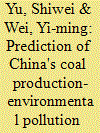| Srl | Item |
| 1 |
ID:
109627


|
|
|
|
|
| Publication |
2011.
|
| Summary/Abstract |
With rapid economic growth and industrial expansion, China consumes more coal than any other nation. Therefore, it is particularly crucial to forecast China's coal production to help managers make strategic decisions concerning China's policies intended to reduce carbon emissions and concerning the country's future needs for domestic and imported coal. Such decisions, which must consider results from forecasts, will have important national and international effects. This article proposes three improved forecasting models based on grey systems theory: the Discrete Grey Model (DGM), the Rolling DGM (RDGM), and the p value RDGM. We use the statistical data of coal production in China from 1949 to 2005 to validate the effectiveness of these improved models to forecast the data from 2006 to 2010. The performance of the models demonstrates that the p value RDGM has the best forecasting behaviour over this historical time period. Furthermore, this paper forecasts coal production from 2011 to 2015 and suggests some policies for reducing carbon and other emissions that accompany the rise in forecasted coal production.
|
|
|
|
|
|
|
|
|
|
|
|
|
|
|
|
| 2 |
ID:
111444


|
|
|
|
|
| Publication |
2012.
|
| Summary/Abstract |
This paper proposes a hybrid model based on genetic algorithm (GA) and system dynamics (SD) for coal production-environmental pollution load in China. GA has been utilized in the optimization of the parameters of the SD model to reduce implementation subjectivity. The chain of "Economic development-coal demand-coal production-environmental pollution load" of China in 2030 was predicted, and scenarios were analyzed. Results show that: (1) GA performs well in optimizing the parameters of the SD model objectively and in simulating the historical data; (2) The demand for coal energy continuously increases, although the coal intensity has actually decreased because of China's persistent economic development. Furthermore, instead of reaching a turning point by 2030, the environmental pollution load continuously increases each year even under the scenario where coal intensity decreased by 20% and investment in pollution abatement increased by 20%; (3) For abating the amount of "three types of wastes", reducing the coal intensity is more effective than reducing the polluted production per tonne of coal and increasing investment in pollution control.
|
|
|
|
|
|
|
|
|
|
|
|
|
|
|
|
| 3 |
ID:
166327


|
|
|
|
|
| Summary/Abstract |
In recent years, the Chilean energy sector has gone through a significant transformation. Chile ratified the Paris Agreement in 2017 and committed to develop policies to face climate change and to transition to a more sustainable energy system. Promoting renewable energy and energy efficiency became an essential strategy for Chile to reduce emissions and reach its energy and environmental goals, which are addressed in various governmental studies. Further, Chile became successful in promoting renewable electricity production without feed-in tariffs. The current national goal is for at least 70% of the electricity in Chile to be generated from renewable energy sources by 2050. Additionally, energy efficiency is to be implemented in several sectors. This paper provides a broad overview of the energy sector and review of the Chilean energy policy development and environmental targets with emphasis on recent years. Finally, it also proposes an assessment about existing and required energy policy instruments for Chilean energy sectors by considering the promotion of renewable energy and energy efficiency and analyses the associated potential challenges. This work can provide insights to decision makers to develop long-term sustainable energy plans for Chile to reach its energy and environmental goals.
|
|
|
|
|
|
|
|
|
|
|
|
|
|
|
|